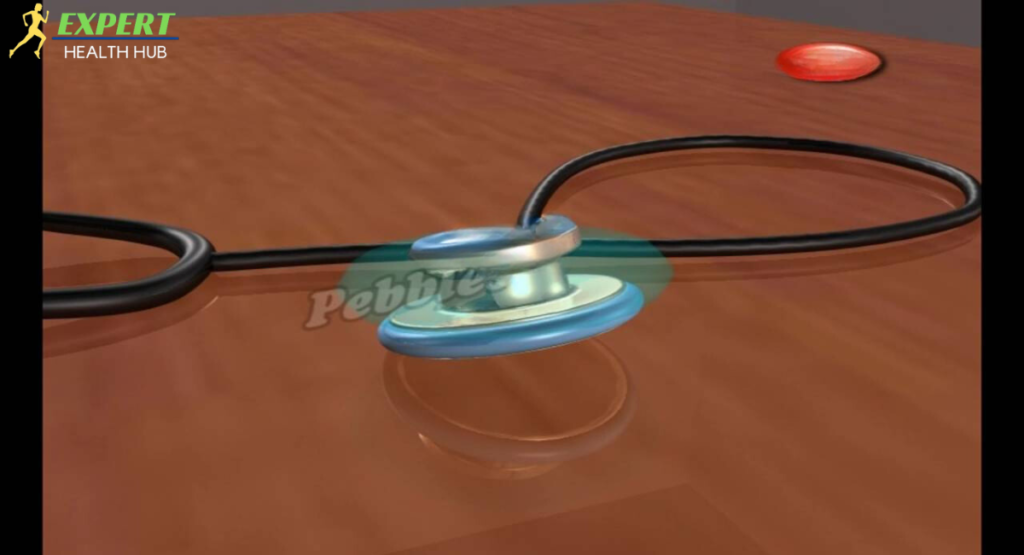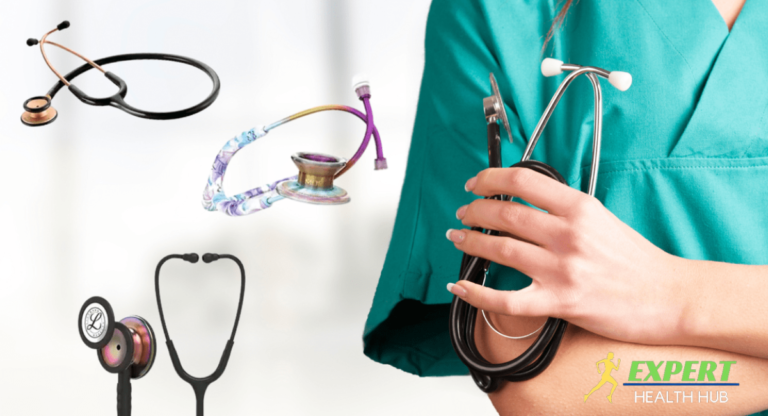How Does a Stethoscope Work? A Fun and Friendly Guide
How Does a Stethoscope Work?
Introduction:
If you are searching for how does a stethoscope work then your search has ended. In this article, you learn about how does a stethoscope work.
Have you ever wondered how your respiration and pulse rate are detected by those weird devices that doctors wear around their necks? Get ready for an amazing journey ahead! In this humorous tutorial,
We’ll learn all about stethoscopes and how they let doctors listen in on your bodily sounds. Get ready for a magical adventure into the world of medical wonders!
Pro Tip: Learn more about Cure autoimmune disease in 30 days then visit our site regularly. We will give you full and detailed information.

How a Stethoscope Works
Interchangeable breastplate
Consider the chest piece a two-part musical instrument, where the bell plays the lower notes and the diaphragm plays the higher ones. Just imagine being able to control the channels on your body’s radio with a remote!
Diaphragms that can be adjusted:
Imagine yourself adjusting the diaphragm to the exact level at which you like the music played on your headphones.
The chestpiece functions as a double agent, transmitting your body’s whispers to your ears through the tubing when you press it against your skin.
Flexible pipe
Building Blocks:
The tubing is like a lifeline; it carries the sound from the chestpiece to your ears in a clean and undistorted form. There is no fuzziness here; it’s like having a direct connection to the performance platform!
Imagine a message in a bottle passing down the tubing and arriving at your ears clearly; this is the principle of sound wave conduction.
It’s like your body sending you texts!
Listening to music on a high-end stereo is all about that crystal-clear sound, and that’s why proper tubing is so important.
The earbuds
Having the Right Fit and Comfort:
The snug fit of earpieces over your ears ensures a comfortable and snug listening experience. Comfort is key, and it’s as cozy as pulling on your favorite fuzzy socks on a chilly day!
Earpieces provide sound isolation, so you can concentrate on the music produced by your body without interruption. Imagine listening to a raucous concert with noise-canceling headphones—every beat is audible!
A Variety of Ear Tips:
Similar to shoe shopping, ear tips are available in a wide range of sizes and shapes to provide a snug and comfortable fit.
Pro Tip: If you are interested in learning the What is the Potential of Bioxtron for Diabetes Management? then visit our site regularly. We will give you full and detailed information.
The Stethoscope and How It Works
Recording Audio

Everything You Should Know About the Chestpiece The chestpiece records the sounds of your heart, lungs, and other organs; it functions similarly to a stage microphone.
All of the various frequencies that your body produces, including high-pitched heartbeats and low rumblings in your lungs, may be heard by a decent stethoscope. This is similar to how you can set the equalizer on a music player to hear every note.
Position Regarding the Patient’s Body:
It’s important to make sure you hear every syllable while positioning the stethoscope accurately on the patient’s body, just like when you aim a microphone at the lead singer on stage!
The Transfer of Musical Signals
The tube connects the chestpiece to your ears, allowing sound waves to go through a hidden pathway—think of it as a direct line to your body’s orchestra!
The amplification mechanism of a stethoscope is similar to turning up the volume on a song you love, except that the instrument you’re listening to is your own body. This allows even the faintest of whispers to be heard.
Quality of Sound Transmission:
Having crystal-clear sound is like listening to your favorite song without any interference or static—it’s essential for picking up on even the most minute changes in your body!
Analysis of Muscle Sounds
Training and Skill Development: Learning to understand your breathing and heartbeats requires practice, just like learning a new language.
Stethoscopes are used by medical practitioners to differentiate between normal and abnormal sounds; it’s similar to a detective searching for hints in a narrative.
Including in Clinical Evaluation:
The results of a stethoscope examination, in conjunction with other indicators, provide an overview of your current health status.
Pro Tip: If you are interested in learning about Chronic Pain Syndrome ICD 10: Decoding the Alphabet Soup of Pain then visit our site regularly.
Various Chestpiece Options
Blood clot

The diaphragm is like a highly sensitive microphone; it can pick up the tiniest murmurs of the heart and the noises of the lungs, making it ideal for picking up on minute changes in your heart rate.
For evaluating heart sounds:
The diaphragm is like a doctor listening in on your heart to make sure everything is going well; it’s your closest friend in cardiac concerns.
Appropriate for the Vast Majority of Exams:
The diaphragm is as reliable and flexible as a Swiss army knife, so it can handle anything from regular checkups to unexpected crises with ease.
The phone
Capturing low-frequency noises:
The bell is great for picking up the faintest lung noises because it goes deep into your body to do just that.
To evaluate lung sounds:
The bell is an invaluable tool for assessing lung sounds; it’s as if you had a pulmonary specialist standing by to listen for any indications of airway problems.
The bell isn’t as adaptable as the diaphragm, but it’s an absolute must-have for some tests—it’s like having an expert on speed dial for those pivotal moments when you need that additional push.
Mixture of Chestpieces
Why limit yourself to just one function when you may have dual functionality with the diaphragm and bell? You get the best of both worlds with a combination chest piece; it’s like owning a multipurpose tool!
Examination Flexibility:
A combination chest piece equips you with all the tools you need to tackle any challenge that comes your way, like a superhero utility belt.
Features Common to Contemporary Stethoscopes:
Combination chest pieces are now a standard issue; it’s like ordering french fries with a burger—you just expect it! No matter your level of experience, a combo chest piece will meet your needs
Pro Tip: Learn more about how to reverse gum disease
Materials for Tubing and Their Design
CVC Pipe

The most popular material for beginner stethoscopes is PVC tubing, which is like driving a dependable old car: it gets the job done, is economical, and will last a long time.
Inexpensive and Long-Lasting:
PVC tubing is an excellent example of how to benefit all parties involved when you discover a bargain for a high-quality product.
Sound quality may degrade.
PVC tubing isn’t the most high-tech option, but it serves its purpose just fine. It’s like listening to a classic radio broadcast—imperfect but enjoyable nonetheless!
Non-Latex Tubing
Those who are allergic to latex:
Latex-free tubing is a lifesaver for people who suffer from latex allergies. It’s like getting a golden ticket to a candy factory; now you can eat all the candy you want without worrying about triggering your allergies!
This tubing is latex-free, but it doesn’t sacrifice sound quality in any way. It’s like having the best of both worlds: safety and performance! The use of latex-free tubing is an eco-friendly alternative that benefits both you and the earth.
It’s like driving an electric car—good for the environment and excellent for you!
Double-Lumen Pipes
With dual-lumen tubing, sound waves travel at a VIP express lane—quickly, efficiently, and with pristine clarity—it’s like flying first class; once you try it, you won’t want to go back!
Less Interference:
Enjoy your music uninterrupted by background noise with dual-lumen tubing. It’s like having a personal concert in your ears!
Though more expensive initially,
The premium option of dual-lumen tubing in high-end stethoscopes is well worth the investment. It’s like taking a day trip to a fancy spa—a real pleasure, but well worth it!
Pro Tip: If you are interested in learning whether Is It Possible to Exercise Too Much Helpful for Health in 2024? then visit our site regularly. We will give you full and detailed information
Choosing the Right Earpieces
The Right Fit

The goal of properly fitting earphones is to seal off any potential sound leakage, much like a boat with a leaky mast.
Long-Term Comfort:
No one wants aching ears from listening all day, so it’s important to get earphones that fit well. Think of it like selecting the ideal running shoes—only for your ears!
Prevents Ear Fatigue:
Just like finding a pair of shoes that you can dance in all night without experiencing any pain in your feet, properly suited earpieces distribute pressure evenly, allowing you to listen to body symphonies all day without discomfort.
Noise Cancellation
You may tune out the world and concentrate on your inner melodies with the help of noise-canceling earbuds. It’s like cranking up the volume on your favorite tune; the earbuds magnify your sounds while dampening any distracting ambient noise.
Crucial for Precise Diagnosis:
In the realm of medical diagnosis, each nuance matters; discerning minute irregularities requires audible, undistorted sound, much like listening to a beloved tune in its purest form.
Personalize Your Choices
Stethoscopes come in a variety of ear tip sizes, so you may select the perfect one for your ears. It’s like finding the perfect pair of shoes—a personalized fit!
You can have ear tips made of a variety of materials, such as hard plastic or soft silicone, depending on your preference and level of sensitivity to allergies. It’s like picking out your favorite pair of sneakers or the coziest pair of socks!
Availability of Snap-On Rim and Other Add-On Attachments:
Users can personalize their stethoscopes with optional attachments to make them more usable and more aesthetically pleasing. It’s like adding accessories to your favorite gadget to make it uniquely yours!
How to Use a Stethoscope Properly
Proper Body Positioning
Positions for Heart Auscultation:
Hold the stethoscope over the chest, where the heart is located; this is analogous to putting your stethoscope on a radio to listen to current music.
When auscultating the lung, place the stethoscope over various parts of the body, much like you would use the remote control to select your favorite program on television.
Positions for Abdominal Auscultation:
Swing the stethoscope around the belly in four different directions, as if searching for the ideal radio station.
Pro Tip: Learn more about Skin Tightening Treatments for Stomach: Unveiling Tummy Secrets
Modifying the Position of the Earpiece
Making Sure They Fit:

It’s like donning a pair of noise-canceling headphones for a private concert; you want to have the best seal possible.
Earpiece alignment is like fine-tuning a radio antenna.
it maximizes sound transmission by directing the sound waves where they will have the greatest chance of reaching the listener.
Comfort is crucial when it comes to preventing discomfort or ear fatigue. Find a pair of shoes that fit comfortably enough to wear all day by adjusting the earpiece alignment.
Approaches to Active Listening
Listening Carefully:
Doctors and nurses may pick up on minute changes in your heart rate, respiration rate, blood pressure, and other physiological signals. It’s like honing in on every note of your tune.
As they gain experience, practitioners learn to distinguish between typical and aberrant patterns of bodily sounds, much like an ear can tell the difference between a harmonious song and a discordant note.
Clinical Findings and Patient History:
The results of an auscultation are combined with the patient’s medical history and symptoms to provide a complete picture.
Pro Tip: Learn more about Household chores are a good way to fit exercise into your everyday routine.
Unique Stethoscopes for Various Medical Fields
Medical Devices for the Heart
Cardiology stethoscopes have enhanced acoustic sensitivity, allowing the user to hear even the most minute of heart sounds, such as gallops and murmurs.
These stethoscopes are like a magnifying glass for your heart’s rhythm; they focus on heart sound assessment by making sure the sounds are clear.
Designed with the specific requirements of cardiologists and cardiovascular experts in mind, it’s like having a one-of-a-kind instrument for every task.
Stethoscopes for Children
The small chest piece is like a stethoscope that fits your little one perfectly; it’s designed for infants and youngsters.
Customized for children:
With its specially designed diaphragms and bells, it’s as if you had a stethoscope calibrated to pick up on the distinct sounds that children make.
Essential resources for pediatric healthcare are perfect for pediatricians and pediatric nurses—it’s like having a reliable friend by your side when you care for kids.
Veterinary Ultrasound Devices
As if you had a stethoscope made specifically for your feathery, scaly, or furry buddy, this device is designed for animal patients.
The chestpiece is adjustable to fit animals of all sizes, so it’s like having a stethoscope that fits any species.
Utilized Frequently by Veterinarians and Veterinary Technicians: It’s essential for the well-being of animals—it’s as if you have a reliable companion taking care of your pet.
Pro Tip: Learn more about Signs you are recovering from anxiety
Improvements in the Technology of the Stethoscope
Connected Medical Devices
You might think of digital sound processing as an HD upgrade for your body’s soundtrack; it uses cutting-edge technology to improve sound quality.
Features of the amplifier:
customizable settings for the best possible listening experience, exactly like fine-tuning your favorite music.
Recording Features:
You can record and listen to your sounds, just like a musician records their music.
Connectivity via Wireless Means
Mobile Device Integration:
Pair it with your phone or tablet, and it’s like listening to your body’s symphony as it happens.
Use applications for remote monitoring to keep tabs on your health—it’s like getting a virtual checkup.
Support for telemedicine services—it’s as if you could bring your doctor with you wherever you go—is known as telemedicine compatibility.
High-Tech Earpieces
The use of artificial intelligence to augment decision-making is like carrying about a personal diagnostic assistant.
Instantaneous feedback during patient interactions—it’s as good as getting a second opinion right then and there—thanks to real-time analysis algorithms.
Integrating with EHRs:
Keeping a digital score of your body’s symphony—seamless documentation and data exchange.
Pro Tip: Learn more about Kill Tooth Pain Nerve in 3 Seconds Permanently
Upkeep and Repair of Your Stethoscope
Maintaining a Clean Environment
Cleaning the Chestpiece and Earpieces: Just like giving your stethoscope a spa day, wipe them down with alcohol.
Just like giving your stethoscope a bubble bath, gently wash the tubing and headset with soap and water to keep them clean.
Like putting your stethoscope to bed at the end of a hard day, it is best to keep it in a clean, dry place.
Upkeep for the Future
Looking for signs of wear and tear is similar to checking your vehicle for dings and dents while checking the integrity of the tubing.
Like oiling a creaky door hinge, lubricating rotating components keeps things moving smoothly.
For both comfort and cleanliness, it’s a good idea to replace your ear tips regularly, just like you would with your toothbrush.
Common Problems and Their Solutions
If noise is distorted or muffled, unclogging a drain or other obstruction may be to blame.
Look for indications of wear, such as cracks or discoloration in the tubing, just like you would for a water hose leak.
Fix a loose screw or replace a missing part if it is loose.
How to Pick the Best Stethoscope for Your Situation
Keeping the Usage Environment in MindDepending on whether you’ll be working in a clinical setting or the field, you’ll need to select an appropriate tool.
Targeted Specialization (e.g., Cardiology, Pediatrics): It’s like carrying around a toolbelt full of gadgets—tailored to your specialty.
Use Case and Expected Lifespan:
Spend your money wisely, and you’ll have a dependable vehicle for many years to come.
Finances and Expenses to Think About
Discover the optimal balance between features and affordability—it’s like getting the most out of your money.
Prioritizing Long-Term Investment Over Short-Term Spending:
Saving for the future is like putting money into high-quality goods; it will last a long time.
Think about the big picture—it’s like getting stethoscope insurance—with the available warranty and after-sale support.
Conclusion:
In this article, we complete a discussion about how does a stethoscope work, So there you have it—the stethoscope’s inner workings exposed! We have investigated every crevice of this extraordinary medical wonder, from the chestpiece to the earpieces.
What this means is that the next time a doctor wears a stethoscope around their neck, they aren’t merely listening to your heartbeat; they are tuning into the symphony of your body’s rhythms!
If you have any questions related to how does a stethoscope work ask me in a comment, and I will answer you.
Pro Tip: Learn more about Twisted Tea Nutrition Facts
FAQs:
Q1: For what reason does a doctor always tap the stethoscope’s chestpiece before using it?
Ans: To make sure the chest piece is in the right place and doesn’t contain anything that could block the sound, doctors tap it. It’s as if you were to gently rouse the stethoscope just before the concert starts!
Q2: Is it possible to listen to one’s own heart with a stethoscope?
Ans: In a heartbeat! A stethoscope can be used by anyone to listen to their heartbeat; however, perfecting the location may require some practice. Imagine having a front-row ticket to the performance of your very own personal concert in your body!
Q3: How come stethoscopes are available in a rainbow of hues?
Ans: You can find stethoscopes in a wide range of colors to match any professional’s or patient’s taste. Choosing an outfit is a lot like this: why wear a dull color when you can rock a bright one?
Q4: Is the sound quality of electronic stethoscopes superior?
Ans: When compared to older, more inefficient acoustic models, modern electronic stethoscopes provide superior clarity and fidelity thanks to their use of cutting-edge technology to improve sound quality and amplify auscultated sounds.
Comparable to leaping from a flip phone to a smartphone, once you feel the difference, you won’t want to go back!
Q5: When is the best time to clean my stethoscope?
It is recommended that healthcare practitioners clean their stethoscopes frequently, preferably after each use, to avoid the spread of infections and cross-contamination. In terms of patient safety and hygiene, it’s as basic as washing your hands.
Pro tip: To learn more about health and fitness-related knowledge, regularly visit Quora, Linked, Twitter, Pinterest, Instagram, YouTube, and Facebook.






